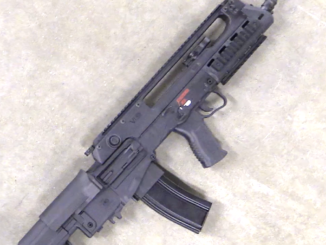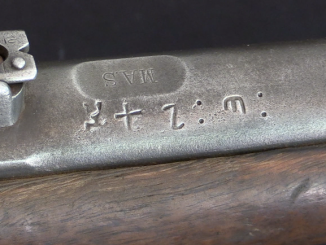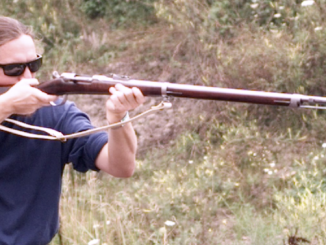Preorders now open for my book, Chassepot to FAMAS: French Military Rifles 1866-2016! Get your copy here!
In the late 1950s, France was still part of the NATO integrated military structure. When the 7.62x51mm cartridge was adopted as standard for the alliance, France looked to be in a good position to simply convert their MAS 49-56 rifles to use it. After all, the 7.5mm cartridge the rifle was designed for was very similar to the new NATO round. After several years of trials, however, the project was dropped as impractical. It turned out that the much different pressure curve of the 7.62mm round would require significant redesign of the MAS rifles. They suffered from poor extraction, broken parts form high bolt velocity, and other issues (not coincidentally, the exact same problems reported with the 308 MAS 49-56 rifles imported by Century…). The St Etienne factory only made a total of 150 of them in 7.62x51mm before the project ended.




“(…)suffered from poor extraction, broken parts form high bolt velocity, and other issues(…)”
Incredible, after much development 7,62×51 NATO cartridge which was dimension-wise very close to 7,5×54, did not provided much greater muzzle velocity for bullets of similar mass, yet was unfit to make it work properly in self-loading fire-arms designed for 7,5×54.
But I am still wondered why? Did French and NATO cartridge used different powders?
Clue: look where gas tap is; about 1/2 of (already short) barrel length. With conventional gas pick up it is somewhere between 2/3 and 3/4 of barrel length.
He said the NATO ammo was loaded with a faster burning powder.
You might then think that the French could have used a narrower gas tube. Maybe they tried and it didn’t work?
Slower burning powder typically produces higher chamber pressure. So I wonder what is going on here.
It would be interesting to know what the differences in primers and powder burning rates were.
Was the French load giving a higher pressure peak, or a longer flatter one?
One could argue that the port pressure was higher, given the short length to the port indicates a higher pressure peak. Why they didn’t narrow the gas tube, or even shorten it seems strange. Maybe they tried. Interestingly Garand conversions to 7.62 Nato opened up the gas port, the longer barrel barrel with the gas port near the end due to the earlier conversion from the gas trap variant may have played a role.
Very attractive weapon. Be interested in how it handles. Wonder if a ground up version built for .308 today, using similar layout, wood grip, steel, etc., could not be market success?
Saw one very similar to this years ago, didn’t purchase, because caliber was “goofy French 7.5”. Too bad…
She just has lines that fall in pleasant places. Probably heavy, though, for all that solid state technology built in.
Ok, let’s take a look at both cartridges and specifically at their respective chamber pressure. First the 7.5×54 French:
https://en.wikipedia.org/wiki/7.5%C3%9754mm_French
I availability part is says:
“The pressure is rated at around 40,000 CUP or about 295 MPa (42,800 psi).” This is a typical loading for French produced ammunition, not max. test pressure. Ignore high pressured ratings noted in previous paragraph; it is related to guns related to the cartridge.
Now 7.62 Nato/ .308 Win (although not the same):
https://en.wikipedia.org/wiki/7.62%C3%9751mm_NATO
This ammo (regular production) in known to push pressure in neighborhood of 55kSI in chamber. Also, one important consideration: 7.5 was used first in MAS36, the hotter american cousin in M14 some 20 years later. Is that enough for clue? Not the same time, not the same level of ammunition development.
“(…)MPa(…)psi(…)kSI(…)”
I would recalculate that if I would know definition for kSI pressure unit. Anyway I looked into Deutsch version of that articles and luckily they use common unit.
7,5 x 54: 2650 Bar
7,62 x 51 NATO: 4150 Bar
That is pressure of first is less than 2/3 of second. That explain why MAS 49-56 did not worked well in it. Yet taking that in account I would except more pronounced difference between bullet mass and muzzle velocity or maybe data for these cartridge are given for barrels of much different length?
Here you go… simple answer. Of course, kSI do not make sense to you just as MPa do not make sense to me 🙂
Well yes, barrel length plays into it too, but somehow moderated by capillary effect due to bore/ length ratio. It demonstrates itself by ‘residual pressure’ after bullet is out of barrel.
“”
I want to note that I personally prefers atmospheres (at)
https://en.wikipedia.org/wiki/Technical_atmosphere
with 1 at being equal to 1 kilogramforcepersquarecentimeter
any other acceptable as long as all data are in common unit
My schooling back in Europe, when comes to pressure units, was in atmospheres (atp). However, tensile strength of steel was in kg/mm sq. Later I had to adopt units of new land 🙂
These Pascals/ rascals and derivatives are new to me, but they make inroads in this continent. In Europe it is staple stuff now, just like kW for power/ output. No one talks HP any more.
Just goes to show… Caliber conversions aren’t as easy as everyone thinks.
Taking in account that as already highlighted pressure difference for both cartridge, one saying described undertaken action well: fit a quart into a pint pot
Huh, a significantly higher peak pressure, with a gas port tapping at a much earlier (and higher) point in the curve, and pushing that gas through the action for a SIGNIFICANTLY longer dwell time, and there was major overgassing that caused serious problems, you say?
I’m shocked. Shocked, I tell you.
As a non-American, I now wonder how the Nato 49-56 would have performed in .280Brit/7mmMk1Z…?
Interesting thought, but the pressure curve is so different for the .280 that a complete redesign of gas port placement and the camming surface on the bolt would be in order. Probably other problems would show up as well.
Oddly enough this rifle inspired me to ask why the french did not buy pistol grip stocks for their MAS 49 rifles and as well to wonder about a G3 in 7,5 french. Maybe bought in small numbers by one of the various commando units.
Thank you for the kind words about Century. They have done a lot, often at great financial risk, to bring surplus arms we would never otherwise see to us in the U. S. Given the laws, technology, and physics they have had to work with they should be praised rather than abused.
Bringing in sime supply of 7,5 would probably have been better.
Has anyone tried converting these rifles to the swiss 7,5 mm GP11 cartridge as teh swiss did with their Reibel machineguns?
“(…)Century(…)”
I understand that their choice of 7,62×51 NATO as commonly available, but I am wondering about other possibility, maybe 7,65 mm Mauser (7,65 MM ARGENTINE in U.S. parlance) or 7,9×57 Mauser would result in more reliable weapons?
I have one of the Century conversions to 7.62. The rounds need to be loader with less propellant to reduce the pressure. Fired with the normal load thee shell cases are damaged and thrown a long distance. The alternative is to rework the gas system to reduce the pressure which requires expert gunsmith.
I own one of the Century conversions. I found it to function reliably with reduced pressure handloads. (Essentially handloading handbook “starting loads” with pressures of around 40-42k cup). However, I wanted to have the option of running other ammunition without abusing the gun so I installed an adjustable gas valve. By reducing the orifice size it is possible to compensate for different port pressure by restricting gas flow. This works so well that I am amazed that the French military did not find it a satisfactory solution. Perhaps the issue was in finding a single orifice size that worked in every rifle with every NATO spec lot of 7.62 ammunition? The adjustable orifice certainly does work for tuning but would be a problem if it required field adjustment by the troops.
Can anyone point me in the right direction for a French mas 1949/56 7.62 bolt I recently bought a mas and it was the wrong bolt for it the bolt I have is chambered in 7.5 French and I need a 7.62 bolt